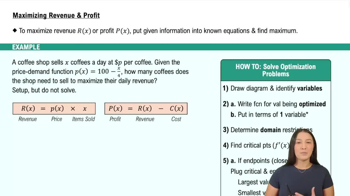Table of contents
- 0. Functions7h 52m
- Introduction to Functions16m
- Piecewise Functions10m
- Properties of Functions9m
- Common Functions1h 8m
- Transformations5m
- Combining Functions27m
- Exponent rules32m
- Exponential Functions28m
- Logarithmic Functions24m
- Properties of Logarithms34m
- Exponential & Logarithmic Equations35m
- Introduction to Trigonometric Functions38m
- Graphs of Trigonometric Functions44m
- Trigonometric Identities47m
- Inverse Trigonometric Functions48m
- 1. Limits and Continuity2h 2m
- 2. Intro to Derivatives1h 33m
- 3. Techniques of Differentiation3h 18m
- 4. Applications of Derivatives2h 38m
- 5. Graphical Applications of Derivatives6h 2m
- 6. Derivatives of Inverse, Exponential, & Logarithmic Functions2h 37m
- 7. Antiderivatives & Indefinite Integrals1h 26m
- 8. Definite Integrals4h 44m
- 9. Graphical Applications of Integrals2h 27m
- 10. Physics Applications of Integrals 2h 22m
5. Graphical Applications of Derivatives
Applied Optimization
Problem 4.5.15
Textbook Question
Minimum sum Find positive numbers x and y satisfying the equation xy = 12 such that the sum 2x + y is as small as possible.
 Verified step by step guidance
Verified step by step guidance1
First, express y in terms of x using the given equation xy = 12. This gives y = 12/x.
Substitute y = 12/x into the expression for the sum, 2x + y, to get a function in terms of x: f(x) = 2x + 12/x.
To find the minimum value of f(x), take the derivative of f(x) with respect to x. Use the derivative rules: f'(x) = d/dx(2x) + d/dx(12/x).
Set the derivative f'(x) equal to zero to find the critical points: f'(x) = 2 - 12/x^2 = 0. Solve for x to find the critical point.
Verify that the critical point found is a minimum by using the second derivative test. Calculate f''(x) and check its sign at the critical point. If f''(x) > 0, the critical point is a minimum.
 Verified video answer for a similar problem:
Verified video answer for a similar problem:This video solution was recommended by our tutors as helpful for the problem above
Video duration:
6mPlay a video:
Was this helpful?
Key Concepts
Here are the essential concepts you must grasp in order to answer the question correctly.
Optimization
Optimization in calculus involves finding the maximum or minimum values of a function. In this problem, we aim to minimize the sum 2x + y while adhering to the constraint xy = 12. This typically requires the use of techniques such as substitution or the method of Lagrange multipliers to find the optimal values of the variables.
Recommended video:

Intro to Applied Optimization: Maximizing Area
Constraints
Constraints are conditions that must be satisfied in an optimization problem. Here, the equation xy = 12 serves as a constraint that limits the values of x and y. Understanding how to manipulate and incorporate constraints is crucial for finding feasible solutions that meet the problem's requirements.
Recommended video:

Intro to Applied Optimization: Maximizing Area
Derivatives
Derivatives are fundamental in calculus for determining the rate of change of a function. In this context, we can use derivatives to find critical points of the function 2x + y, which will help identify minimum values. By setting the derivative equal to zero, we can solve for x and y that minimize the sum while satisfying the constraint.
Recommended video:

Derivatives

 1:13m
1:13mWatch next
Master Intro to Applied Optimization: Maximizing Area with a bite sized video explanation from Callie
Start learningRelated Videos
Related Practice








